This article needs additional citations for verification .(June 2024) |
Bengt Algotsson (also Benedictus; d. 1360) was a medieval Swedish lord. He was the Duke of Finland and Halland, as well as the Viceroy of Scania in 1350s. [1] [2]
This article needs additional citations for verification .(June 2024) |
Bengt Algotsson (also Benedictus; d. 1360) was a medieval Swedish lord. He was the Duke of Finland and Halland, as well as the Viceroy of Scania in 1350s. [1] [2]
Bengt Algotsson's grandfather from the paternal side, Brynolf Bengtsson, was likely a son of Bengt Hafridsson , a lawman in Västergötland. Through his grandmother Ingegärd, daughter of Svantepolk Knutsson, he was descended from both the Danish and Swedish royal houses. [1]
His coat of arms was a standing lion; thus, the family has in some later reconstructions been called Lejon. This may also mean they were kin with the Folkunge, his line's ancestress belonging to those siblings of Boberg family who were nephews and nieces of Birger Jarl.[ citation needed ]
Bengt Algotsson participated in Magnus Eriksson's second crusade to Novgorod in 1350, and was knighted after it. From 1352 he is known to have had a seat in the kingdom's Privy Council. [2]
In about 1353, Bengt was created Duke of Finland and Halland by the King Magnus. [2] The title of Halland came from his descent from Duke Canute of Reval whose male line, which had held Halland as compensation for Reval and Laland, had gone extinct some fifty years earlier. Previous holders of the duchy of Halland had been the king's own father Duke Eric, his mother Duchess Ingeborg, and Ingeborg's second husband Knut Porse, as well as king's half-brothers.[ citation needed ] According to tradition preserved in Vadstena Abbey, Bishop Hemmingus of Åbo would have prevented the appointment of Bengt as the Duke of Finland. However, Bengt's sigil from 1355 includes the phrase Secretum Benedicti ducis Osterlandiarum et Hallandi, indicating that the possible resistance had been overcome by that time. [2] Bengt was also appointed Viceroy of Scania, the newly acquired group of mostly Danish provinces. [1]
Most probably, the chief reasons the king took these steps were to stop the spiritual and secular frälse , to gain yet more power at royal expense, and Hanseatic power in Nordic commerce. The Viceroy confiscated many of the properties of the Archdiocese of Lund upon the death of Archbishop Peder Jensen in 1355. Hanseatic privileges were also curbed in Skanish ports.[ citation needed ]
Duke Bengt was married to Ingeborg Ulvsdotter of Tofta, a member of the Sparre family. She was much older than he, possibly already a widow. Ingeborg was the daughter of Ulf Abjörnsson, justiciar of Tiohärad, the younger half-sister of Lord Karl Ulfsson of Tofta, maternal niece of Erengisle, Earl of Orkney, and the aunt of the future Margaret Sparre of Tofta, mother of Karl Knutsson (Bonde) and ancestress of Gustav Vasa.[ citation needed ]
However, Bengt repudiated his wife sometime in 1356, making his wife's relatives his enemies. A civil war started at about the same time: leaders of Swedish nobility used the king's eldest son Erik as claimant and cited the favorite's exceptional privileges as an insult to the younger king. In 1356 a revolt started, nominally against Duke Bengt, but actually to weaken the king and his centralizing grip.[ citation needed ]
In 1357, Bengt was exiled and Scania as well as several other Swedish and Finnish provinces were given to the young king Erik who ruled the kingdom together with his father. Duke Bengt's elder brother Knut Algotsson was exiled to Norway with his wife Märta Ulfsdotter, a daughter of St. Bridget of Sweden.[ citation needed ]
According to tradition Bengt Algotsson was besieged in Rönneholm Castle in Scania and killed by his brother-in-law Karl Ulfsson and Magnus Nilsson Röde.[ citation needed ]

Magnus Ladulås or Magnus Birgersson was King of Sweden from 1275 until his death in 1290.
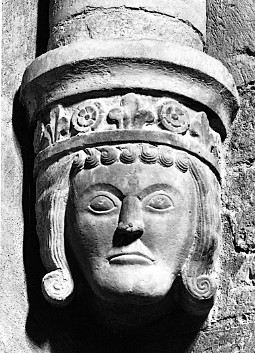
Birger Jarl, also known as Birger Magnusson, was a Swedish statesman and regent, jarl, and a member of the House of Bjälbo, who played a pivotal role in the consolidation of Sweden. His first marriage was to Princess Ingeborg of Sweden, which created his base of power. Birger led the Second Swedish Crusade, which established Swedish rule in Finland. Additionally, he is traditionally attributed with the foundation of the Swedish capital, Stockholm, around 1250. Birger used the Latin title of dux sveorum et guttorum.

Karl Knutsson Bonde, also known as Charles VIII and called Charles I in Norwegian contexts, was King of Sweden and King of Norway (1449–1450).

Magnus Eriksson was King of Sweden from 1319 to 1364, King of Norway as Magnus VII from 1319 to 1355, and ruler of Scania from 1332 to 1360. By adversaries he has been called Magnus Smek.
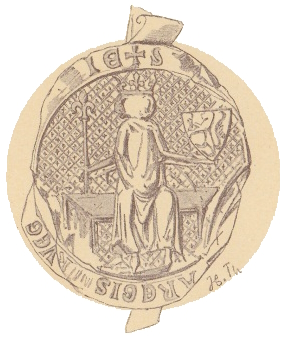
Haakon VI, also known as Håkan Magnusson, was King of Norway from 1343 until his death and King of Sweden between 1362 and 1364. He is sometimes known as Haakon Magnusson the Younger to distinguish him from his great-grandfather, Haakon V.

Birger was King of Sweden from 1290 to 1318. His reign was marked by unrest and civil strife; he was imprisoned by his brothers Erik and Valdemar following the "Håtuna games" in 1306, but when he tried to play them the same trick in Nyköping, there was an uprising that ended with Birger losing the crown and the execution of his 18-year-old son Magnus.

Euphemia of Sweden was a Swedish princess. She was Duchess consort of Mecklenburg, heiress of Sweden and of Norway, and mother of King Albert of Sweden. (c. 1338-1412) .

The House of Erik was a medieval Swedish royal dynasty with several pretenders to the throne between 1150 and 1220, rivaling for kingship of Sweden with the House of Sverker. The first king from the House of Erik was Erik Jedvardsson, later known as Saint Erik. Almost all the subsequent kings of Sweden have been descendants of the House of Erik.

Valdemar Magnusson was a Swedish prince, heir to the throne of Sweden, and Duke of Finland.
Duke of Finland was an occasional medieval title granted as a tertiogeniture to the relatives of the King of Sweden between the 13th and 16th centuries. It included a duchy along with feudal customs, and often represented a veritably independent principality. Grand Duke of Finland was a nominal royal title used by Swedish monarchs from the 1580s until 1720, which was revived again briefly from 1802 to 1805 and was also used by Russia's monarchs until 1917.

Ingeborg of Norway was a Norwegian princess and by marriage a Swedish royal duchess with a position in the regency governments in Norway (1319–1327) and Sweden (1319–1326) during the minority of her son, King Magnus Eriksson. In 1318–1319, she was Sweden's de facto ruler, and from 1319 until 1326, she was Sweden's first de jure female regent. Her role in northern European history is considered of major importance.
Karl Ulfsson was a 14th-century Swedish magnate and High Constable of Sweden.
This lists those feudal magnates who have held Halland (Hallandia) as fief, or its southern or northern part, as a substantive title.
The Fief of Viborg (1320–1534) was for two centuries a late medieval fief in the southeastern border of Finland and the entire Swedish realm. It was held by its chatelain, a fief-appointed feudal lord.

Ingeborg Eriksdotter was a Swedish princess, daughter of King Erik Knutsson, eldest sibling of King Erik Eriksson, wife of Birger Jarl, and mother of Kings Valdemar and Magnus Ladulås.
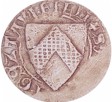
Arvid Gustavsson Sparre, born 1245 in Vik, Balingsta and died in 1317. He was Lord of Ekholmen in Veckholm, Uppland, Sweden. He had in his Coat of Arms, a spar, which has retrospectively dubbed all the family named in genealogies as Sparre of Vik. He was the councillor of Eric, Duke of Södermanland and Valdemar of Finland.

Falkenberg (Falkenbergshus) was a fort located at Falkenberg in Halland County, Sweden. The fortification was located on the south strand of the river Ätran, about 60 m (200 ft) from the southern abutment of Falkenberg Bridge. It would later give name to the town of Falkenberg which was previously known as Ätraby.
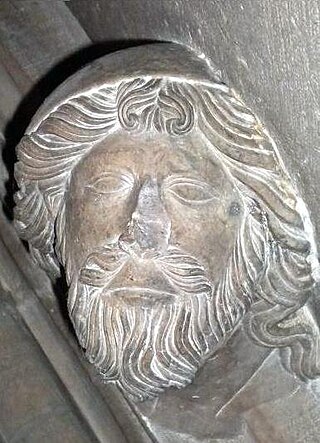
Canute Porse the Elder or Knud/Knut Porse was a medieval Danish nobleman and Duke of Samsø, Duke of Halland, Duke of Estonia, and Count of Kalundborg.
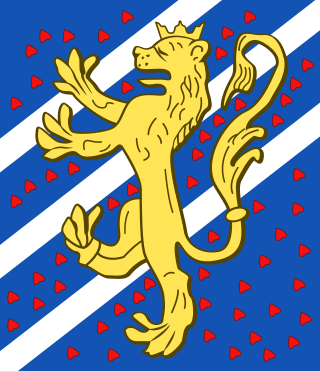
The First Swedish–Norwegian union, was a personal union of the separate kingdoms of Sweden and Norway together with Norway's overseas colonies .The union was founded by King Magnus IV of Sweden in 1319 and dissolved in 1355, briefly re-uniting in 1362 until 1365.